![The Ultimate List of 25 Gluten-Free Cereals [Tested for Hidden Gluten]](https://www.goodforyouglutenfree.com/wp-content/uploads/2021/10/gluten-free-cereals-header.png)
Are you looking for a list of gluten-free cereals you can enjoy when you have celiac disease or gluten intolerance? Well, look no further because I’ve scoured the market for gluten-free cereals you can enjoy. I even tested some cereals you grew up with for hidden gluten, including Cheerios, Lucky Charms, Cheerios, Kix, Fruity Pebbles, and more. This post contains affiliate links. Please see my disclosures. THIS POST WAS LAST UPDATED OCTOBER 2023.
Have you ever wondered which of your favorite cereal brands are still safe to eat now that you’re on a gluten-free diet? Is Raisin Bran gluten-free? And what about Special K, Crispix, and Cocoa Pebbles?
And what are some of the up-and-coming and boutique brands of cereals you can enjoy that are free from gluten?
In this article, I share a list of 25 gluten-free cereals you can enjoy now that you’re on a gluten-free diet.
Please note that I tested many cereals for hidden gluten with my Nima Sensor, a portable gluten-detecting device. To learn more about Nima, please read What You Need to Know About Nima Sensor Before You Buy – Perspective from a Celiac & Nutrition Professional.
How I Determined If a Cereal is Gluten-Free
Here’s how I determined if a cereal is gluten-free:
(1) I looked for gluten-free labeling on the packaging: Does it bear any “gluten-free” claims directly on the packaging itself?
(2) I inspected the ingredient list: Does the ingredient list contain any red flag ingredients, such as wheat, barley, rye, oats, or derivatives of these ingredients, such as malt (barley)? Does it contain any warnings on the packaging?
(3) I conducted additional research online: I researched each cereal brand online, looking at the company’s FAQs and emailing the company directly if needed.
(4) I tested some cereal brands with my Nima Sensor: I used my Nima Sensor to test some cereals for hidden gluten. I didn’t test cereals that clearly contained gluten.
Take, for example, Cocoa Puffs. It doesn’t appear to contain gluten. However, the bottom of the cereal’s ingredient label says, “May Contain Wheat Ingredients.” Therefore, I would assume this cereal contains gluten, and I would not eat it nor test it with my Nima. I already know it’s not safe.
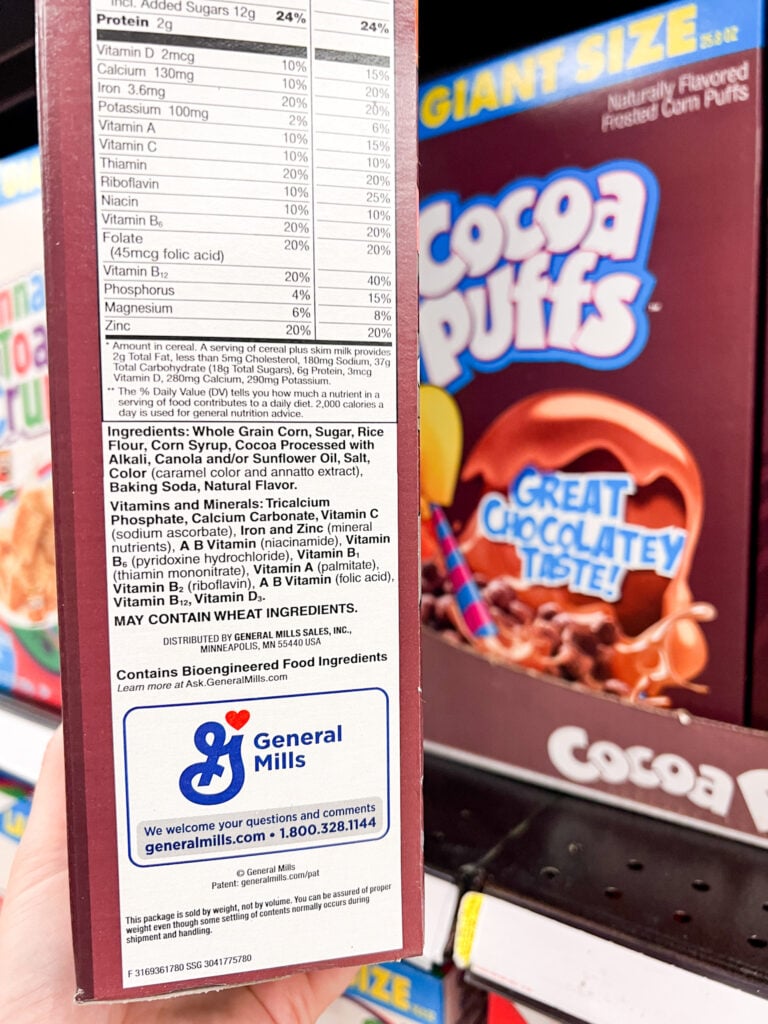
List of 25 Gluten-Free Breakfast Cereals
Check out this ultimate list of 25 gluten-free cereals. Please leave a comment to let me know if I’m missing any.
(1) Annie’s Cinnamon Roll Cereal
Annie’s Cinnamon Roll cereal is the only cereal from Annie’s, which is owned by General Mills, that is labeled gluten-free. It’s made from a combination of sorghum, white rice, and chickpea flour. I haven’t found it in stores yet, but I did spot it on Amazon.
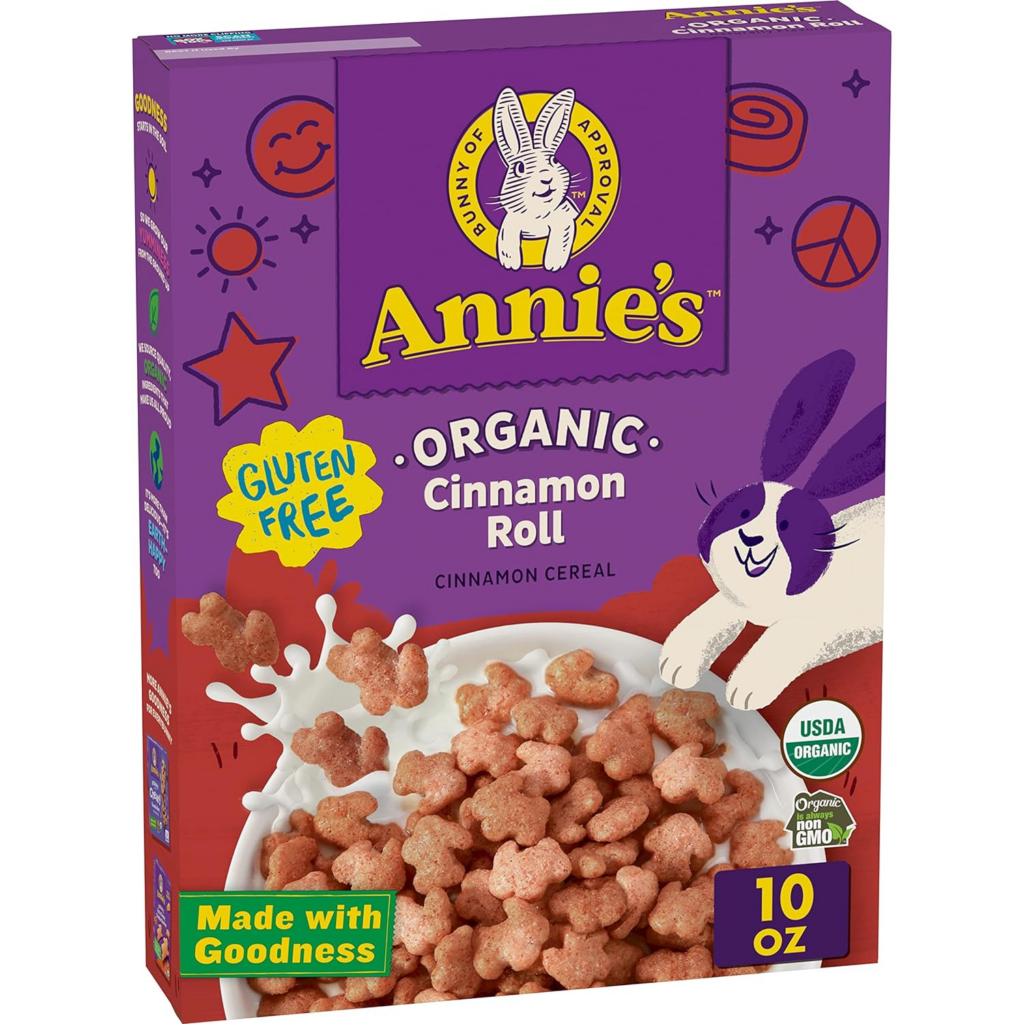
(2) Arrowhead Mills
Arrowhead Mills makes an organic maple buckwheat flakes cereal certified gluten-free by the NSF. Don’t be fooled by the name. Buckwheat is a gluten-free whole grain, even though “wheat” is part of its name. This is the only cereal from Arrowhead Mills labeled gluten-free, so check labels carefully!

(3) Barbara’s Corn Flakes
Barbara’s Corn Flakes are organic and gluten-free, making them a fantastic Corn Flakes option. I’ve spotted them at Sprouts and other grocery stores. Be careful; not all Barbara’s cereals are gluten-free.
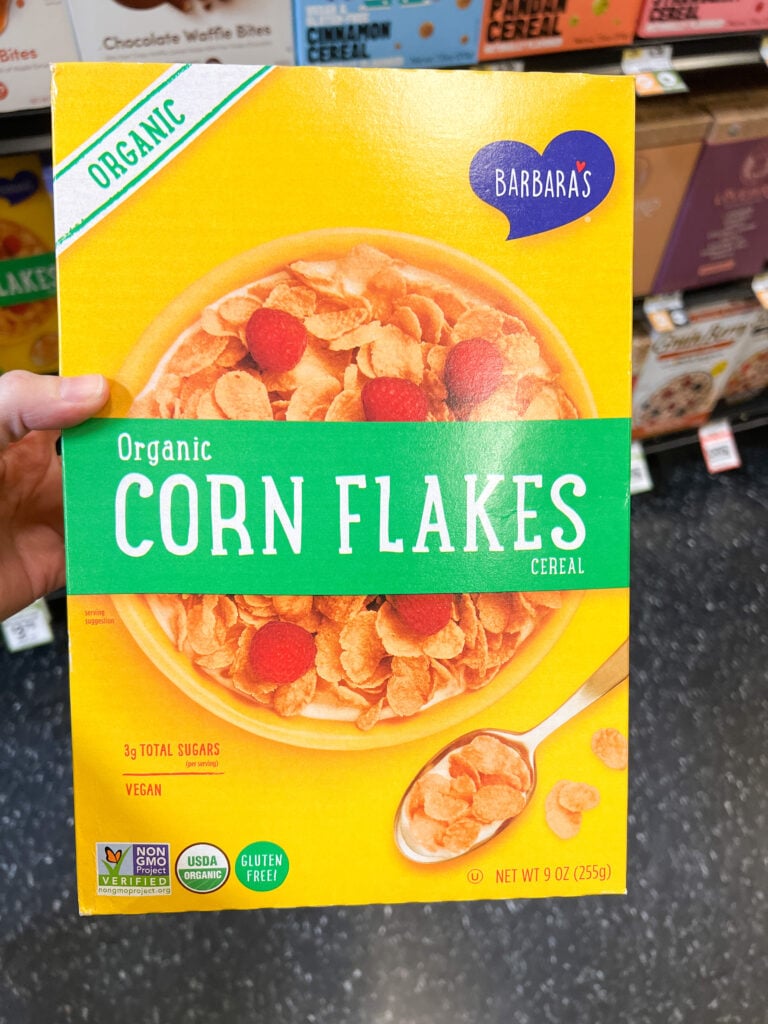
(4) Cascadian Farms
Cascadian Farms makes gluten-free and gluten-containing cereal, so read those labels carefully. That said, its Brownie Crunch cereal is gluten-free, as are its Berry Vanilla Puffs and Fruitful O’s that are reminiscent of Fruit Loops and are not gluten-free.

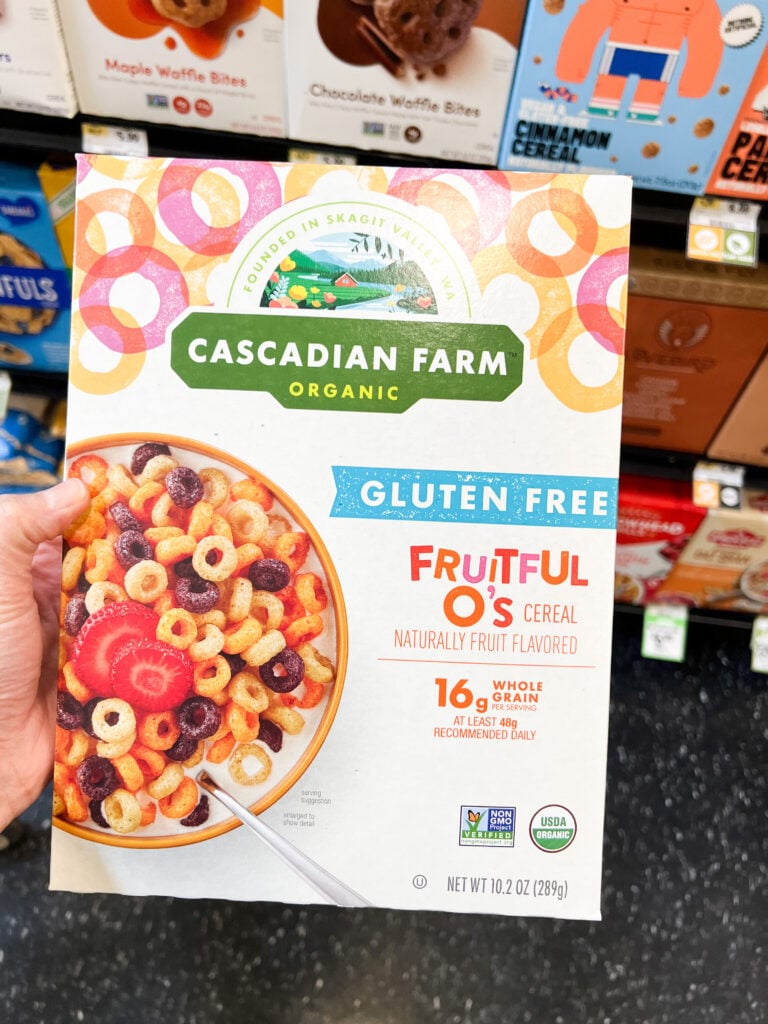
(5) Catalina Crunch
Catalina Crunch makes a variety of keto-friendly cereals, all of which are gluten-free. I tried the Dark Chocolate cereal and did not like it, but my tastes may be different than yours.
All Catalina Crunch cereals are sweetened with Stevia and monk fruit, both of which taste artificial to me. The cereal comes in various flavors, including the pictured Fruity cereal flavor. I spotted a ton of Catalina Crunch varieties at Sprouts.
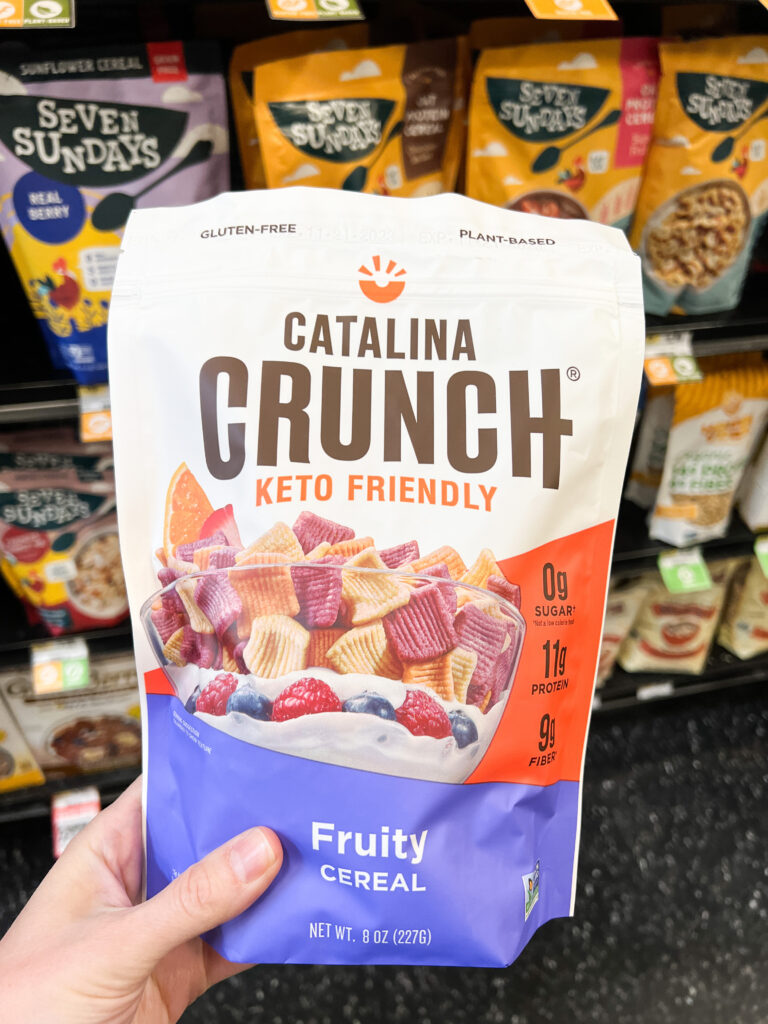
(6) Cheerios
There’s a lot of confusion in the gluten-free community about Cheerios and whether or not the beloved breakfast cereal is gluten-free. I’ve dedicated an entire article to the topic, so be sure to read Unpacking the Gluten-Free Cheerios Controversy: Is It Time to Reconsider Your Stance? In the article, I address pretty much every concern you might have about Cheerios.
For all intents and purposes, if a box of Cheerios is labeled gluten-free, it’s safe to consume regardless if you have celiac disease or gluten intolerance.
I even tested Cheerios for hidden gluten with my Nima Sensor. As you can see, Nima is all smiles for both the original Cheerios and Apple Cinnamon Cheerios.
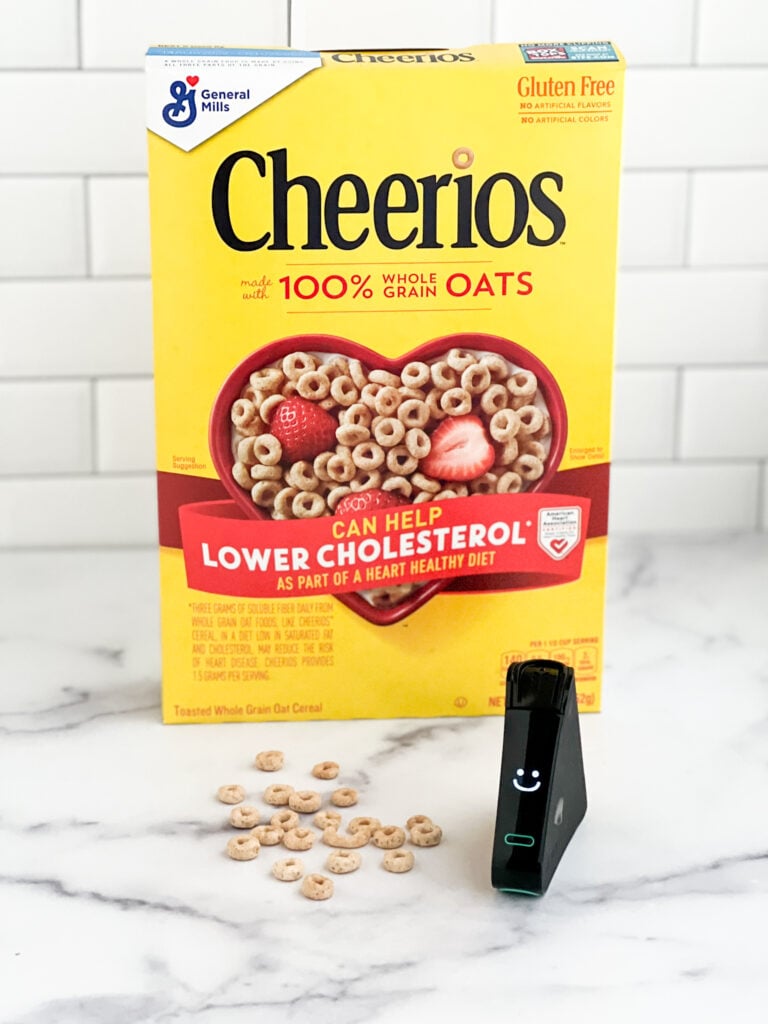
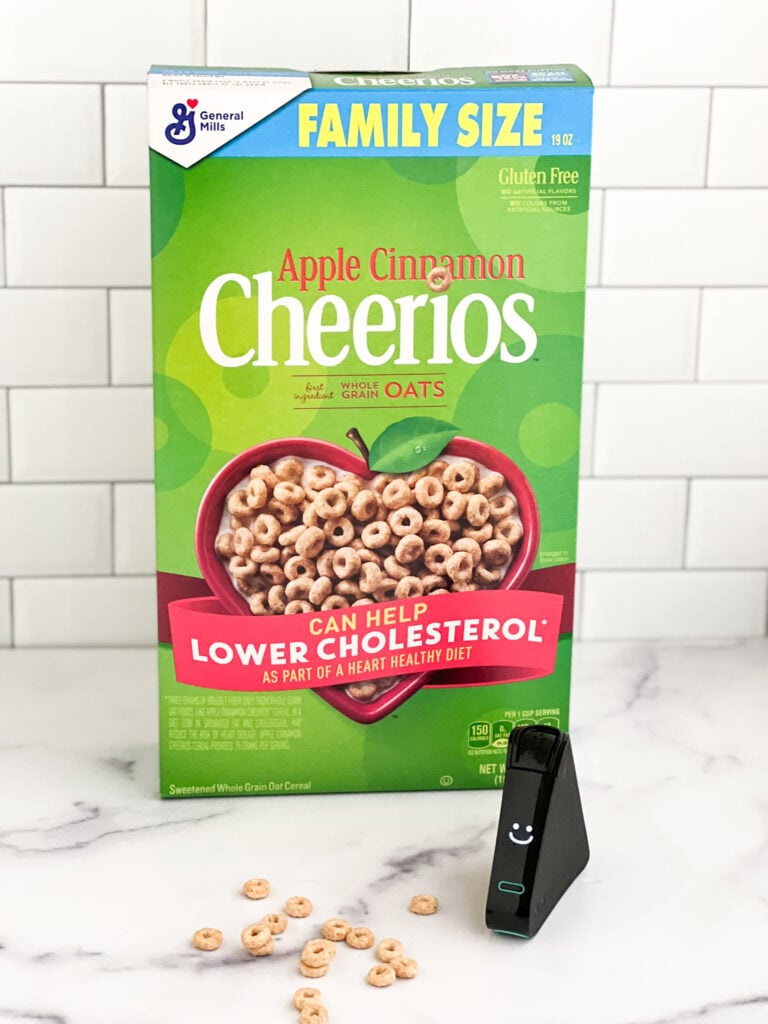
Please note that not all Cheerios are labeled gluten-free. The current Cheerios flavors listed as gluten-free (U.S.-only) include:
- Apple Cinnamon Cheerios
- Banana Nut Cheerios (limited edition)
- Blueberry Cheerios
- Chocolate Cheerios
- Chocolate Strawberry Cheerios (limited edition)
- Cinnamon Cheerios
- Honey Nut Cheerios
- Frosted Cheerios
- Fruity Cheerios
- Maple Cheerios
- Multi-Grain Cheerios
- Peach Cheerios (limited edition)
- Pumpkin Spice Cheerios (limited edition)
- Toasted Coconut Cheerios
- Very Berry Cheerios
Cheerios Oat Crunch recently updated its packaging to say, “Now May Contain Wheat Ingredients,” as pictured below. Beware!

Cheerios in Canada are NOT labeled gluten-free, although they contain the same exact ingredients. Read my article, Unpacking the Gluten-Free Cheerios Controversy; Is It Time to Reconsider Your Stance?, to understand why Cheerios is labeled differently in Canada. It’s quite a head scratcher!
(7) Chex
One cereal brand that is proud to be gluten-free is Chex. The “Gluten-Free” label is written in large print across most (not all) Chex cereal boxes.
You can enjoy all Chex cereals except for the Wheat Chex. Looked for boxes labeled “gluten-free” to ensure you’re buying one of the gluten-free varieties.
Gluten-free Chex varieties include:
- Apple Cinnamon Chex
- Blueberry Chex
- Chocolate Chex
- Cinnamon Chex Cereal
- Corn Chex
- Honey Nut Chex
- Rice Chex
- Vanilla Chex
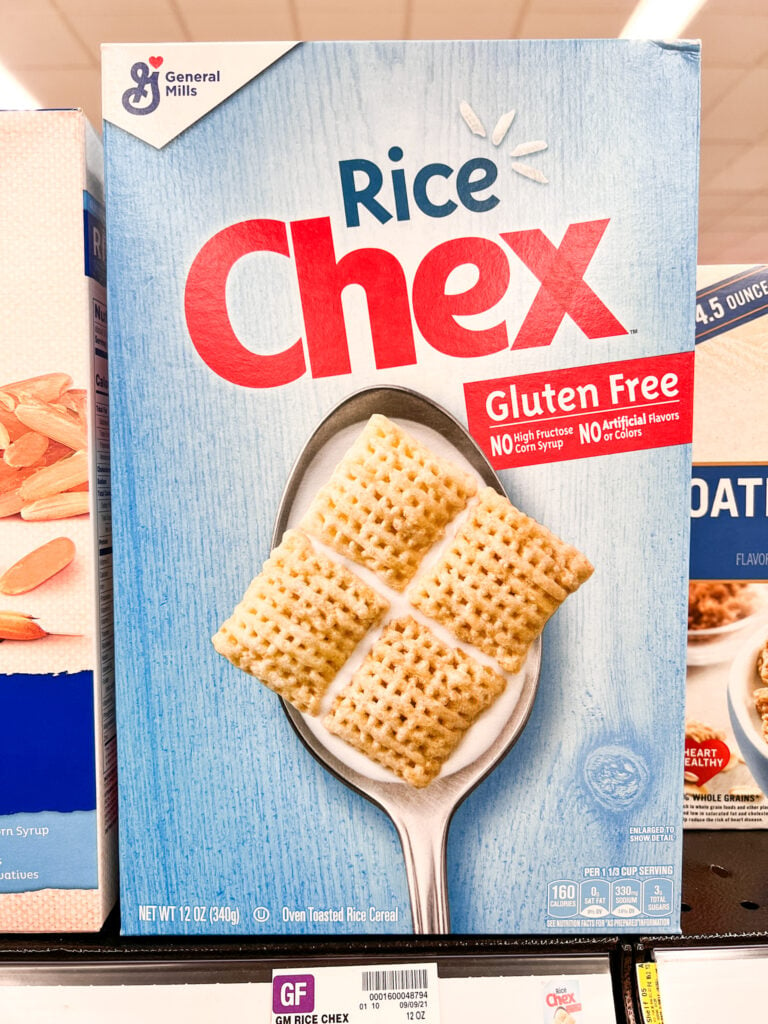
(8) Cream of Rice
While Cream of Wheat cereal contains gluten, Cream of Rice cereal does not, and it makes an excellent Cream of Wheat alternative. I Nima-tested Cream of Rice cereal and Nima didn’t find any hidden gluten.
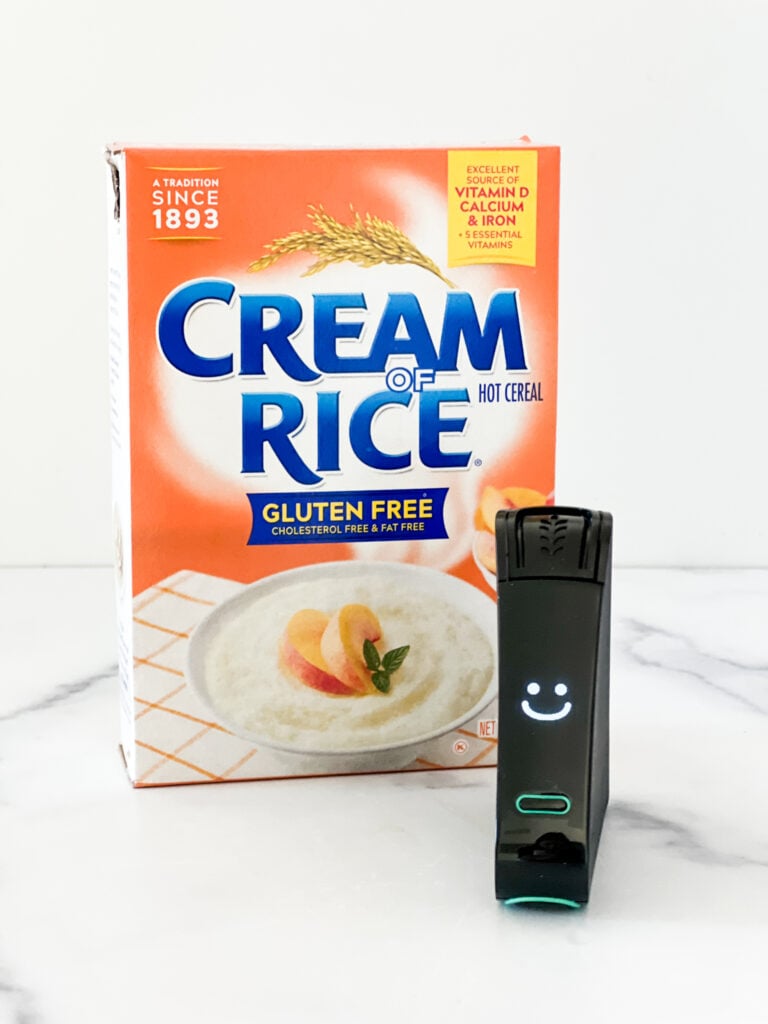
(9) Fruity Pebbles and Cocoa Pebbles
Fruity Pebbles are gluten-free and labeled as such. The “Gluten-Free” label is on the cereal box’s side panel and under the ingredient list.
Fruity Pebbles are made from rice, sugar, oil, and a whole bunch of food dye. There is no gluten in sight, and Nima is all smiles, assuring me that it’s indeed gluten-free.
Please note that Cocoa Pebbles are also labeled gluten-free and safe to consume on a gluten-free diet.
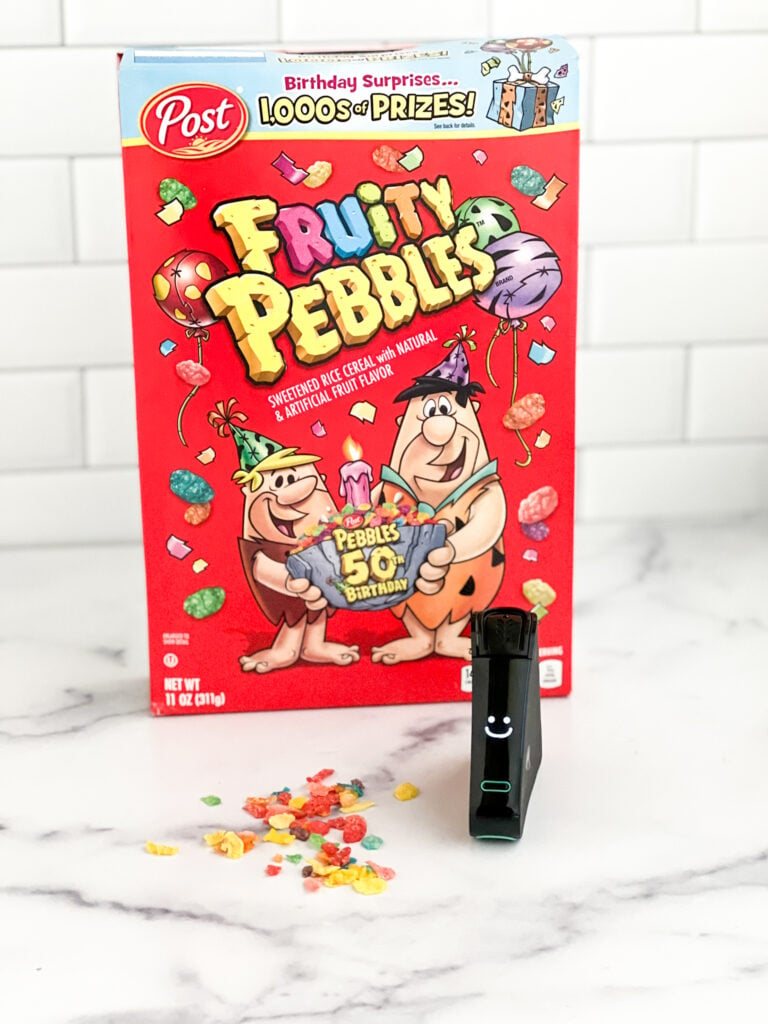
(10) Love Grown Foods
Love Grown cereals are made with beans (aka, plant-based protein) such as navy beans, lentils, and garbanzo beans. The cereal comes in kid-friendly shapes and flavors, including Fruity Sea Stars and Chocolate Comet Crispies.
This cereal brand is one of my favorites and great for picky kids and discerning parents looking for a less sugary alternative to mainstream cereal brands. It looks like the company went through some struggles, and I was not longer able to find it in Sprouts. But it’s now owned by Hive Brands, where you can now buy it. (Picture by Hive Brands)

(11) Lovebird
Lovebird is a grain-free cereal made from cassava, coconut, coconut oil, and Himalayan salt, an ingredient list the brand proudly and prominently features on the front of its boxes, similar to Rx Bars. For those following a grain-free, AIP, or paleo diet, Lovebird cereal is for you!
Lovebird comes in various flavors – honey, cinnamon, strawberry, and cocoa – in addition to the unsweetened cereal below. I spotted all the flavors at Sprouts and on Amazon.
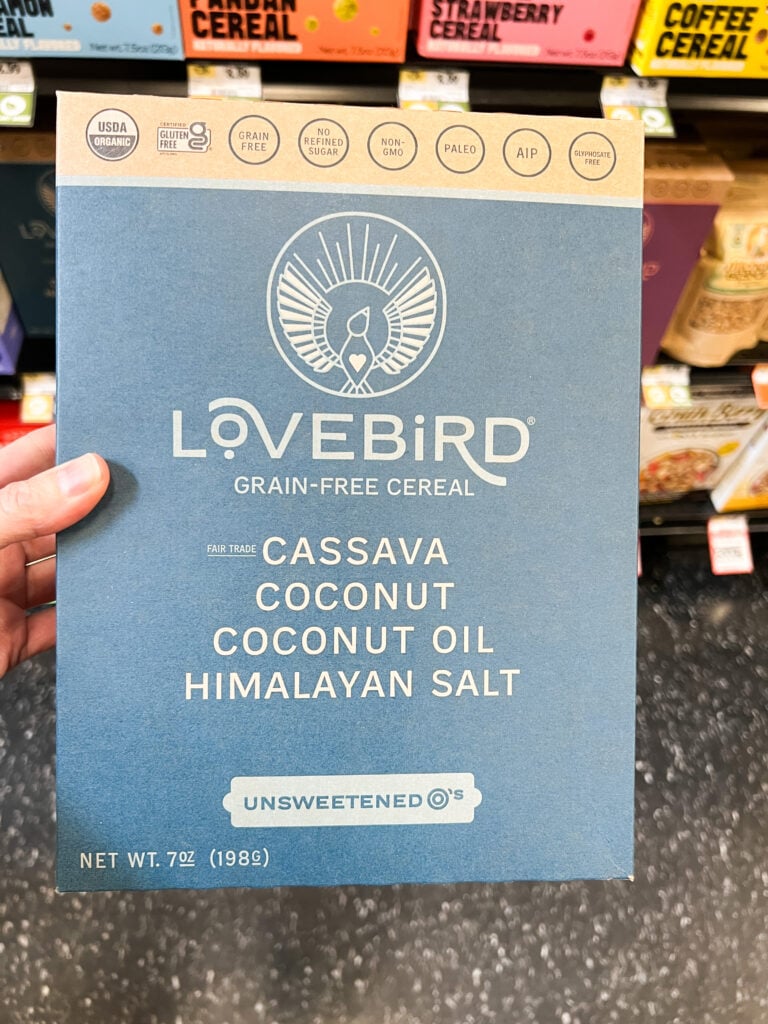
(12) Lucky Charms
According to the Lucky Charms website, the Original Lucky Charms cereal is gluten-free. Because they’re made by General Mills, like Cheerios, some people avoid it for the same reasons they avoid Cheerios.
I put Lucky Charms to the Nima test, and Nima was all smiles. This means Nima didn’t find any hidden gluten.
Please note that Chocolate Lucky Charms and Fruity Lucky Charms are NOT gluten-free. General Mills only guarantees that its Original Lucky Charms contain less than 20 ppm of gluten. Look for the “gluten-free” claim on individual packages of Original Lucky Charms.
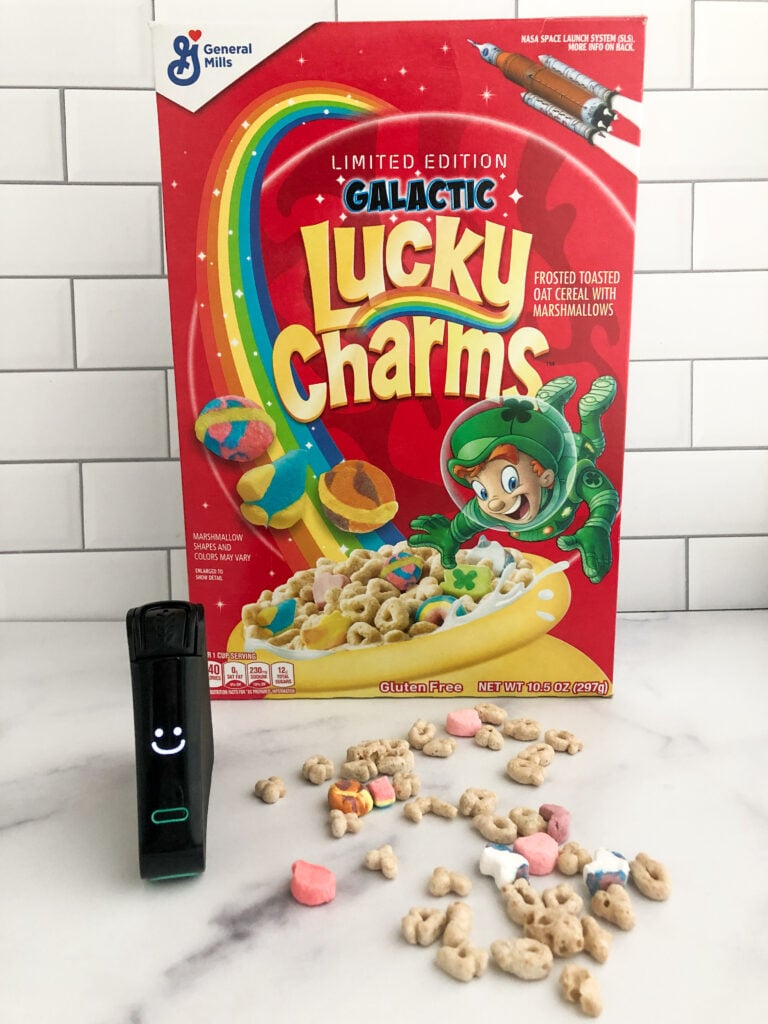
(13) Magic Spoon
Magic Spoon is a kid-friendly cereal that is high in protein and low in carbs. It’s also gluten-free and grain-free and comes in various flavors, including Cinnamon Roll and Fruity, which reminds me of Fruit Loops.
Magic Spoon contains 0 grams of sugar because it’s sweetened with monk fruit. Personally, I found the artificial sweetener taste overwhelming, but the Internet loves this cereal.


(14) Mom’s Best
Mom’s Best makes a gluten-free Crispy Cocoa Rice cereal reminiscent of Cocoa Krispies. Please note that other Mom’s Best cereals are NOT gluten-free. Read those labels carefully.
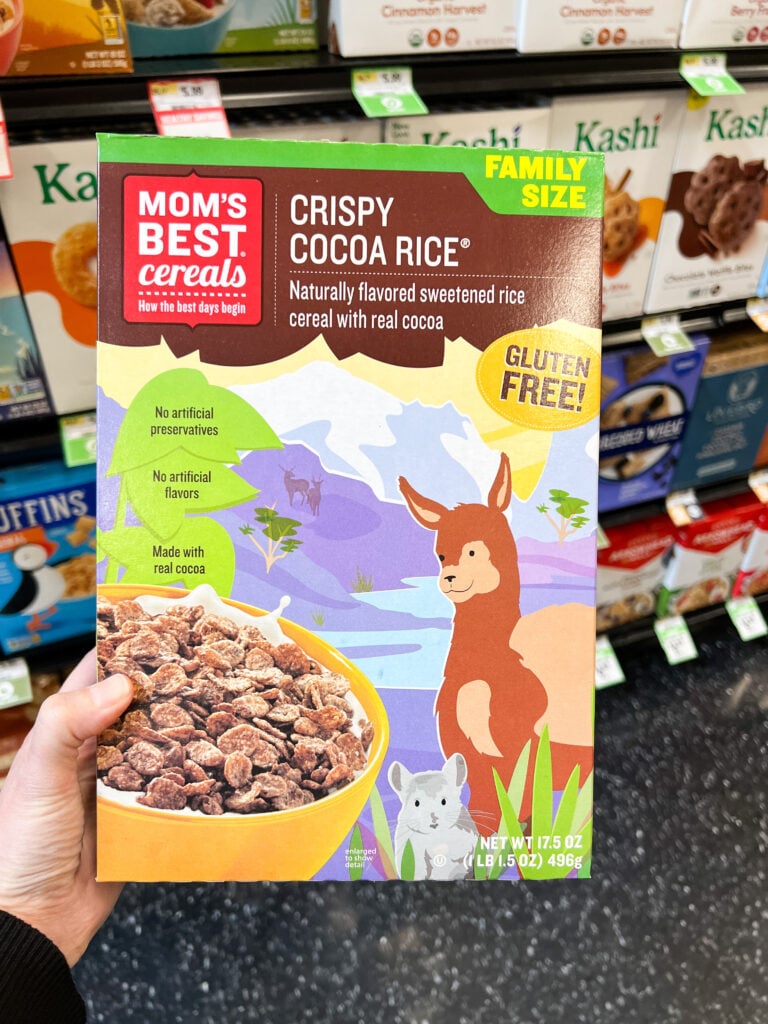
(15) Nature’s Path (EnviroKidz)
Nature’s Path makes a variety of gluten-free cereals, including Mega Sunrise Flakes, Gorilla Munch (looks like Corn Puffs or Kix), Fruit Juice Corn Flakes (a great Corn Flakes substitute since Corn Flakes are not gluten-free), Whole O’s (similar to Cheerios), Crispy Rice Cereal (similar to Rice Krispies, which are not gluten-free), and Koala Crisps to name a few.
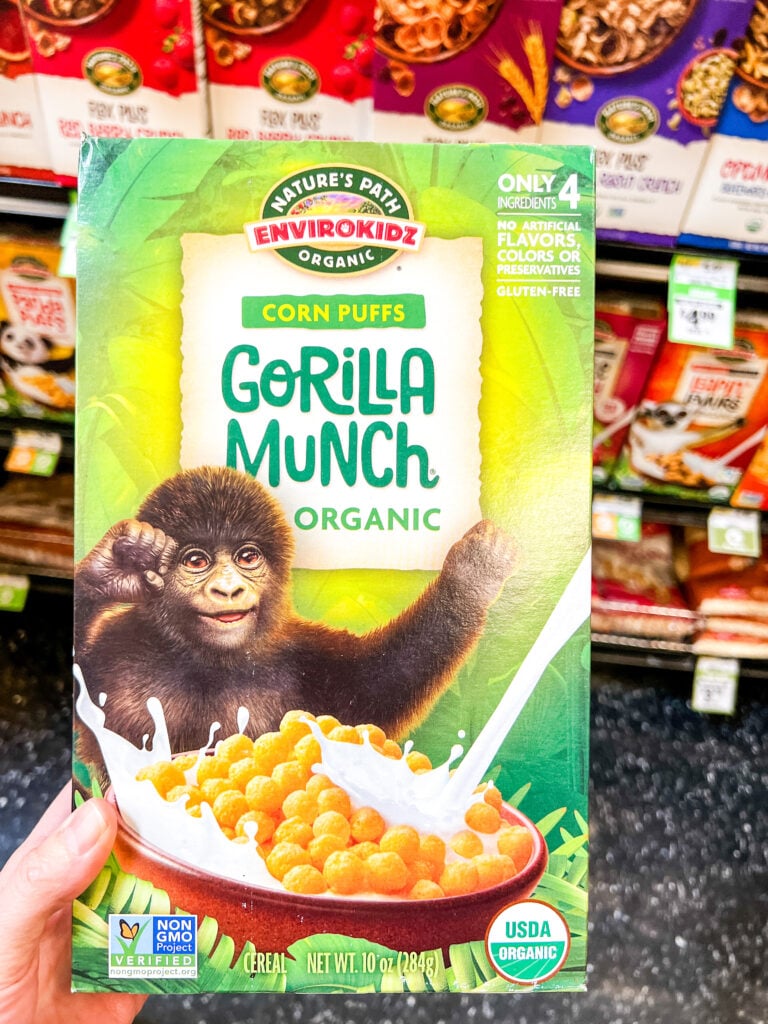
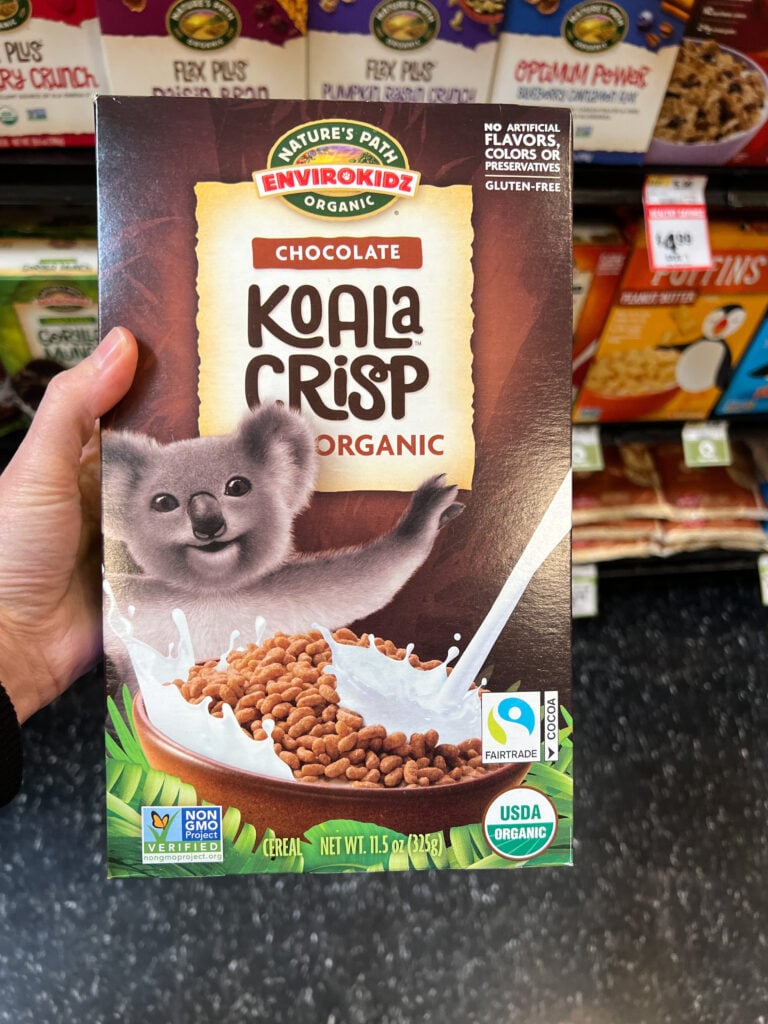

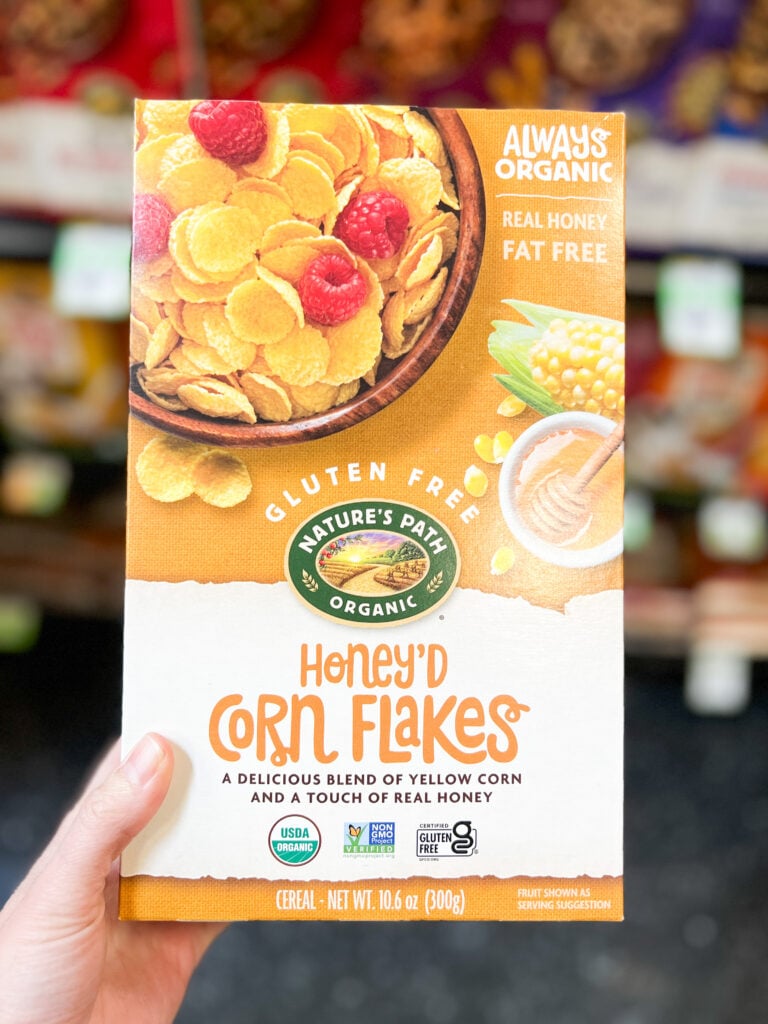
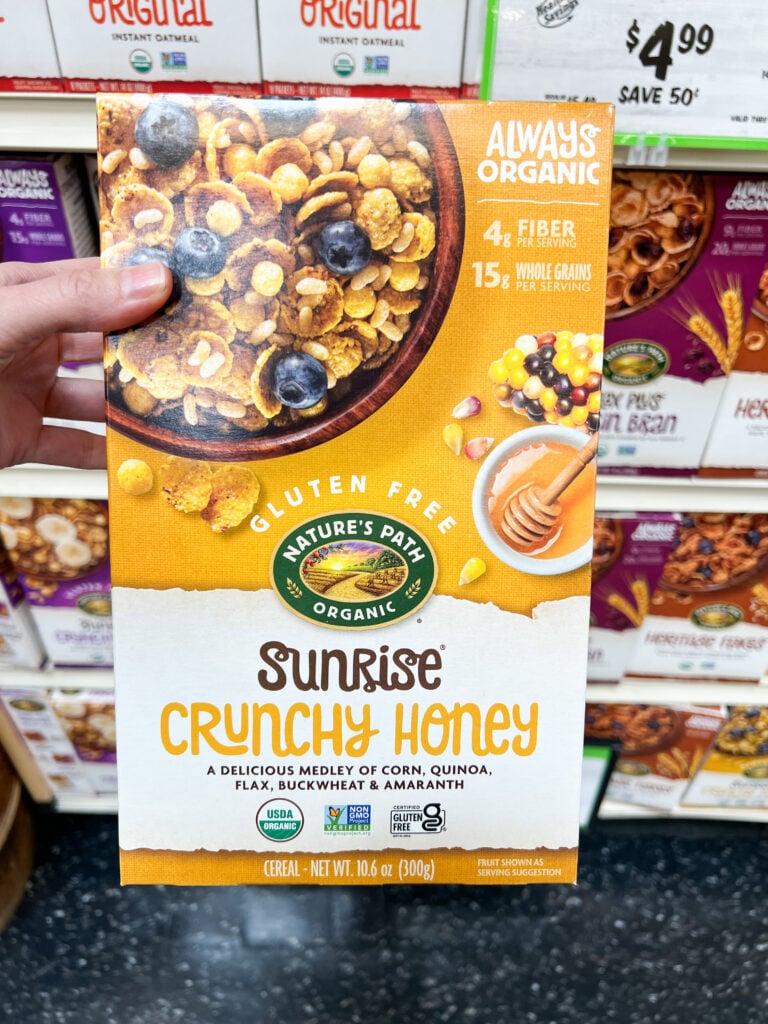
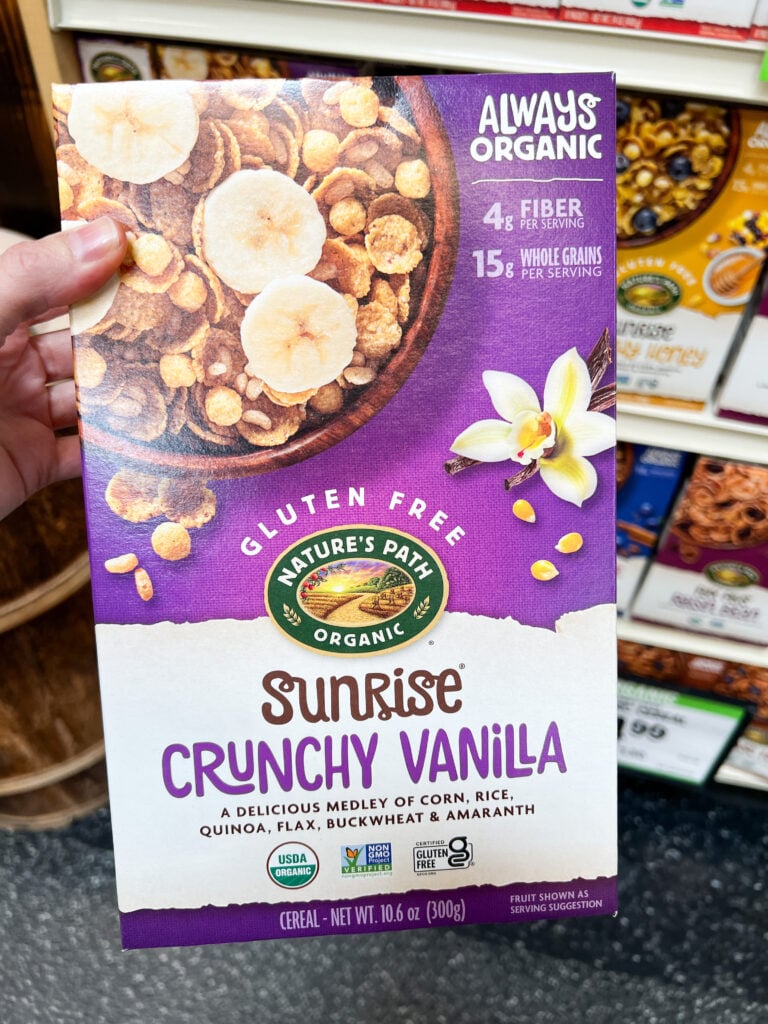
(16) OffLimits
OffLimits makes a quirky-designed cereal that is labeled gluten-free. I found the entire line-up of OffLimits cereal at Sprouts.
The brand boasts four funky mascots – Dash, Zombie, Flex, and Spark – which are featured on each box. And all the flavors are a bit funky, too – including their newest cereal flavor, Pancake & Marshmallow.
The cereal is also organic, vegan, soy-free, non-GMO, and contains no artificial ingredients.
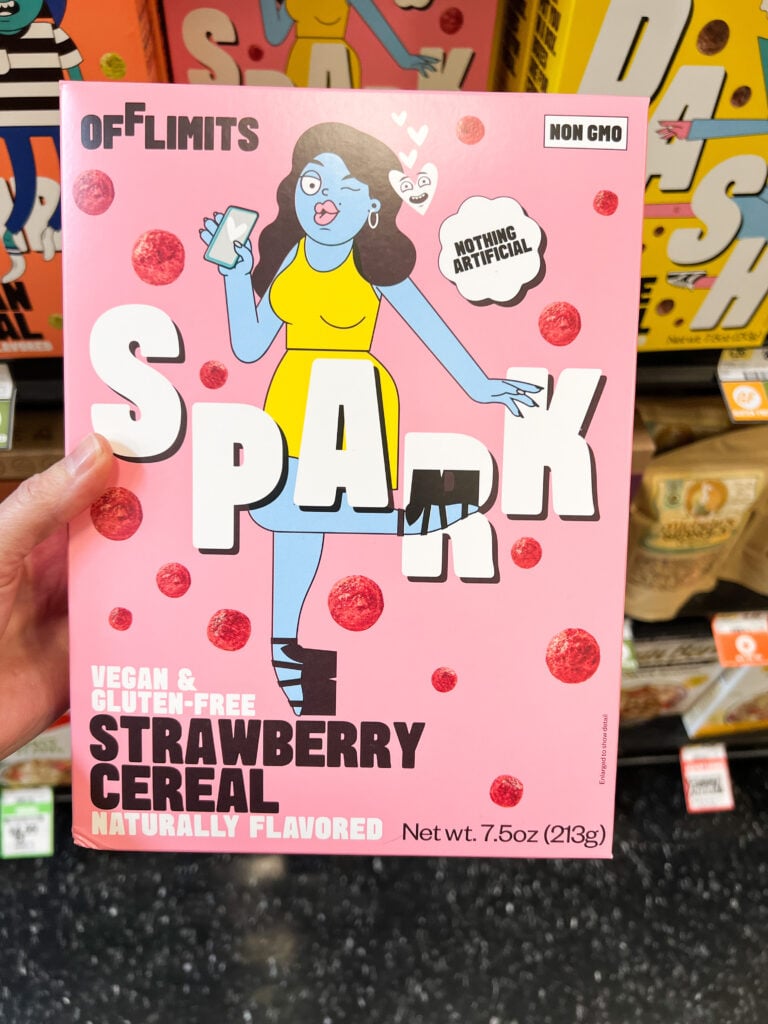
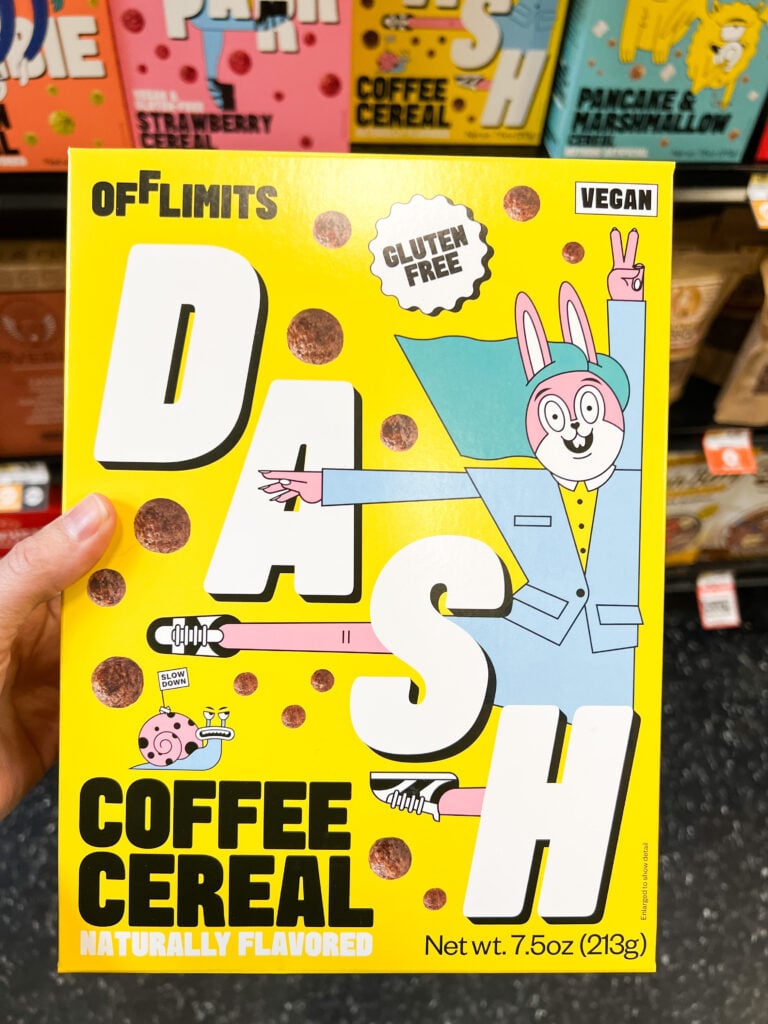
(17) One Degree Organics
One Degree makes sprouted rice cereals that are a good gluten-free alternative to Rice Krispies. I think the cereal tastes good and has a superior taste and crunch. I’ve been buying this cereal for a long time and use it when I make rice crispy treats.
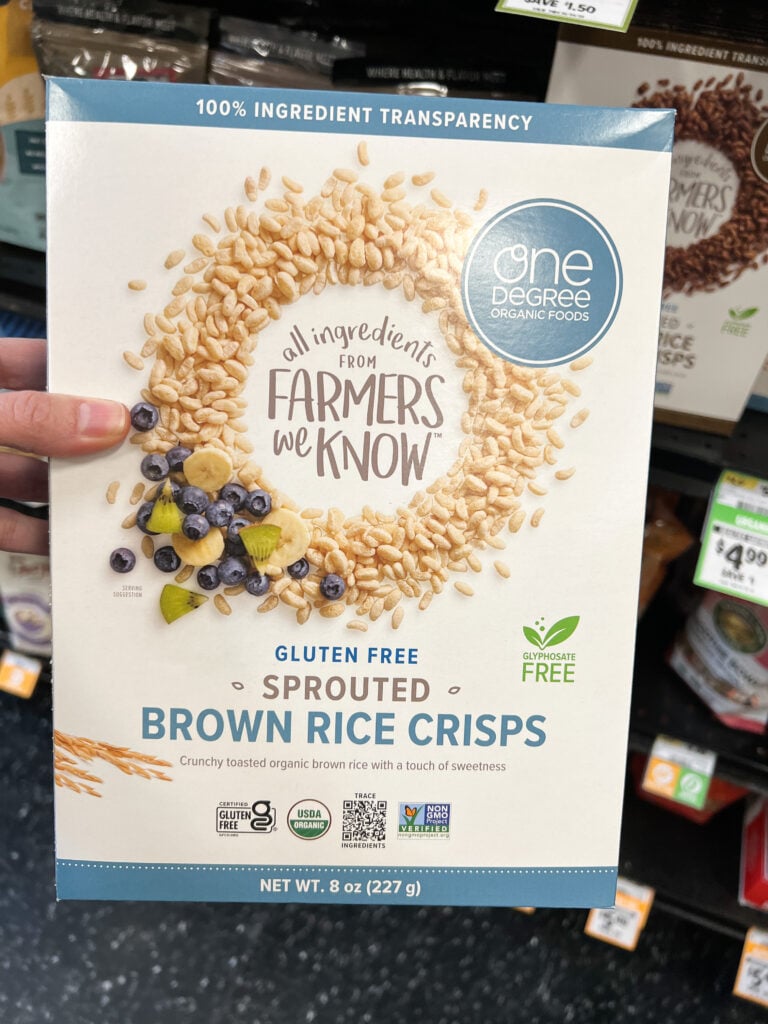

(18) Poop Like a Champion
Thank goodness Poop Like a Champion cereal is gluten-free! Recognized as the #1 brand for #2s, this ultra-high fiber cereal is safe to eat when you have celiac disease.
The cereal is made of corn bran, sorghum flour, ground psyllium, and other ingredients that offer 19 grams of fiber per serving – wow!

(19) Purely Elizabeth
Purely Elizabeth is originally known for its gluten-free granola, and it now offers gluten-free cereal in several flavors – including Vanilla Blueberry Almond and Honey Peanut Butter. All Purely Elizabeth cereals are labeled gluten-free.
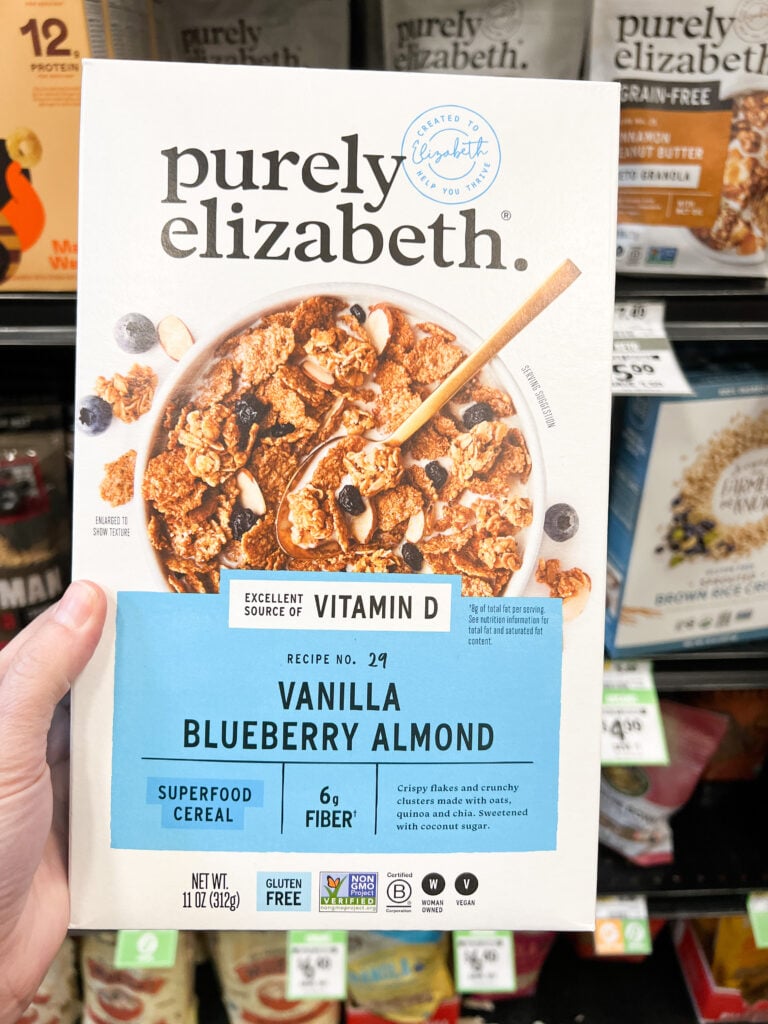
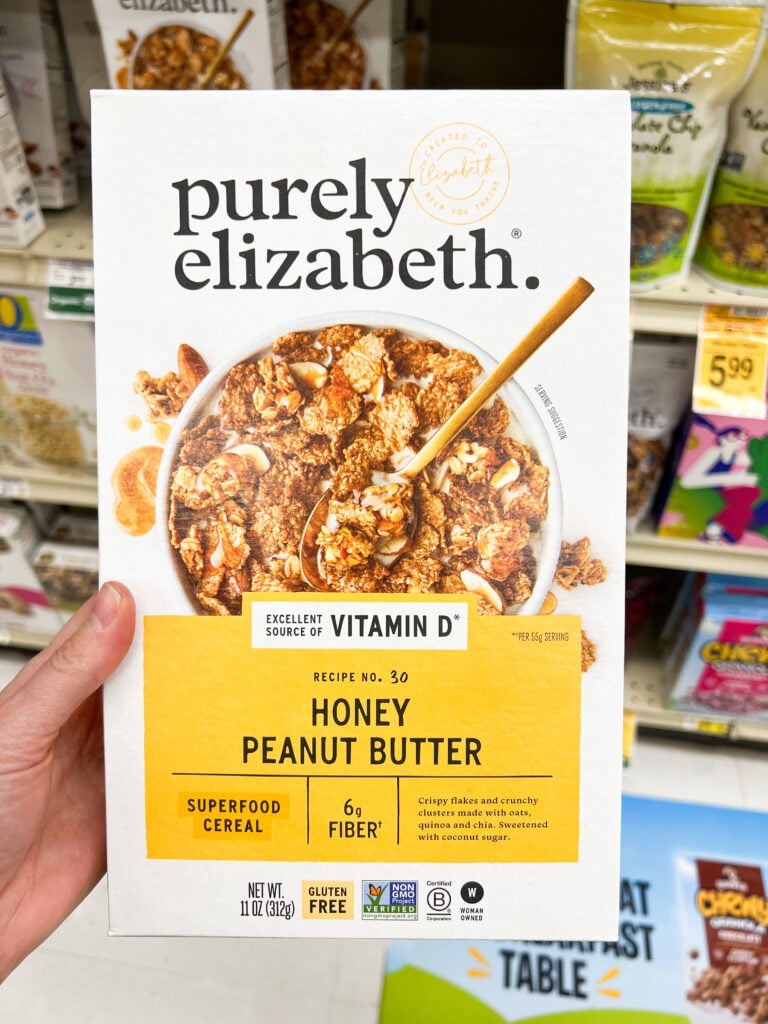
(20) Seven Sundays
Seven Sundays started as a muesli brand but soon moved into making breakfast cereals, too. Now, Seven Sundays makes a variety of gluten-free cereals, including a Fruit Loop-like cereal and a cocoa-flavored sunflower cereal, both of which I found at Sprouts.
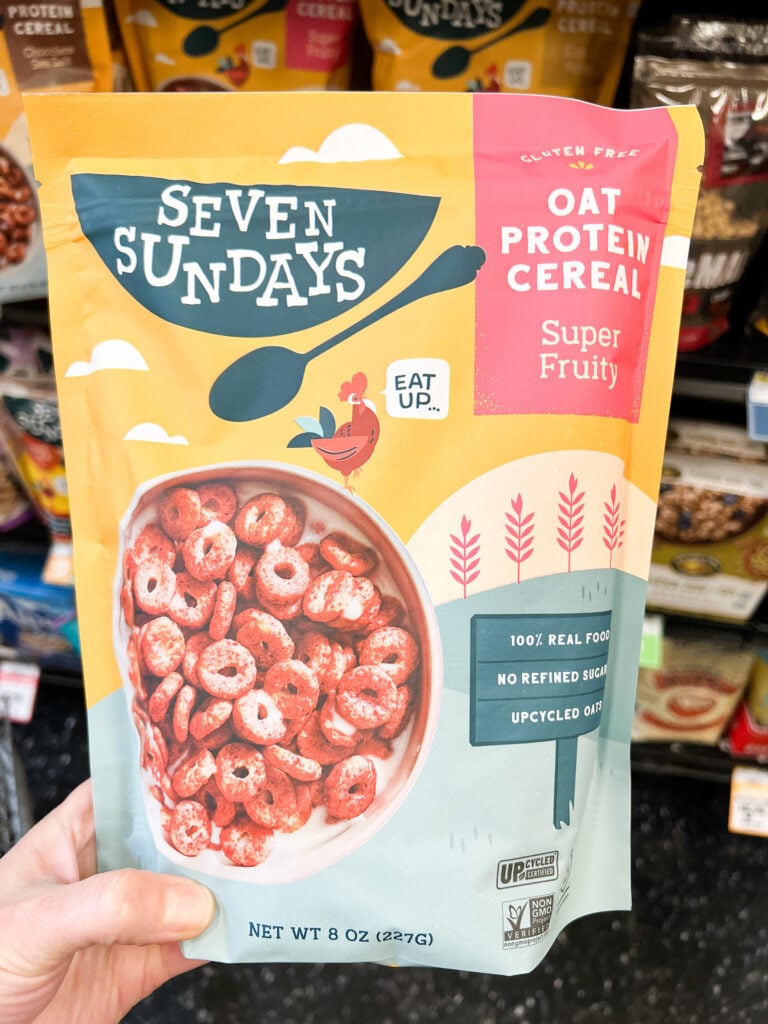
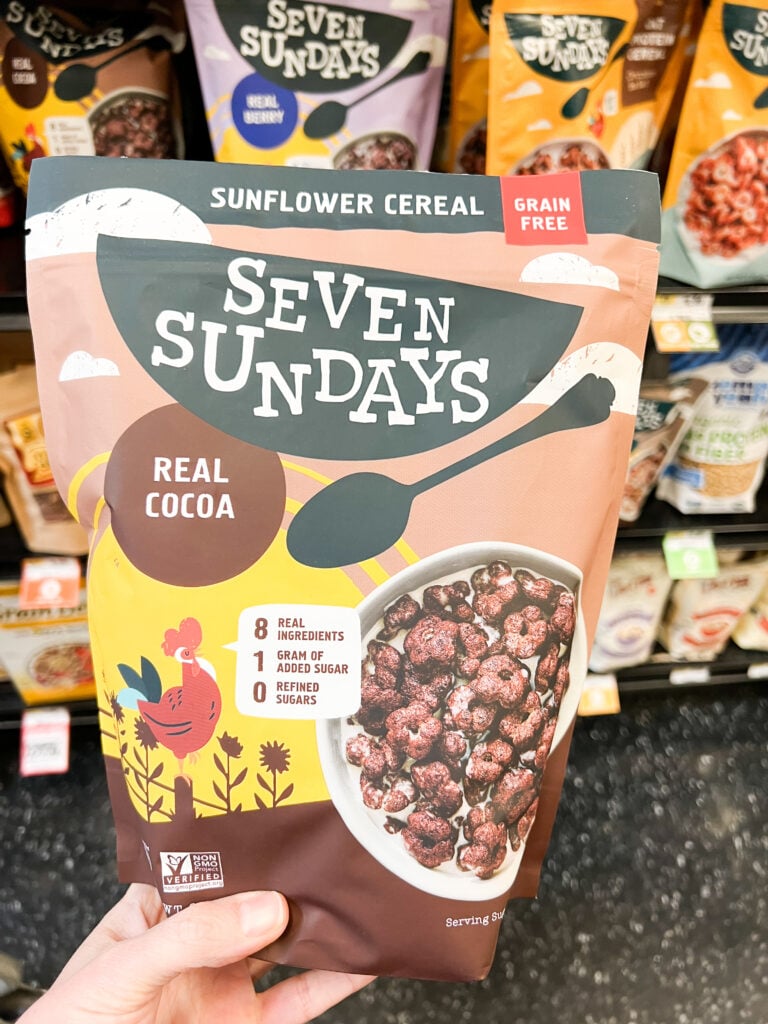
(21) Reese’s Puffs
Reese’s Puffs cereal is made of sweet and crunchy corn puffs coated with peanut butter. The cereal isn’t marked gluten-free, but the ingredient list, which includes whole grain corn, sugar, Reese’s peanut butter, dextrose, corn meal, corn syrup, oil, and artificial flavors, does not appear to contain gluten ingredients.
I tested Reese’s Puffs for hidden gluten with my Nima Sensor, and Nima returned with a smile (no gluten found).
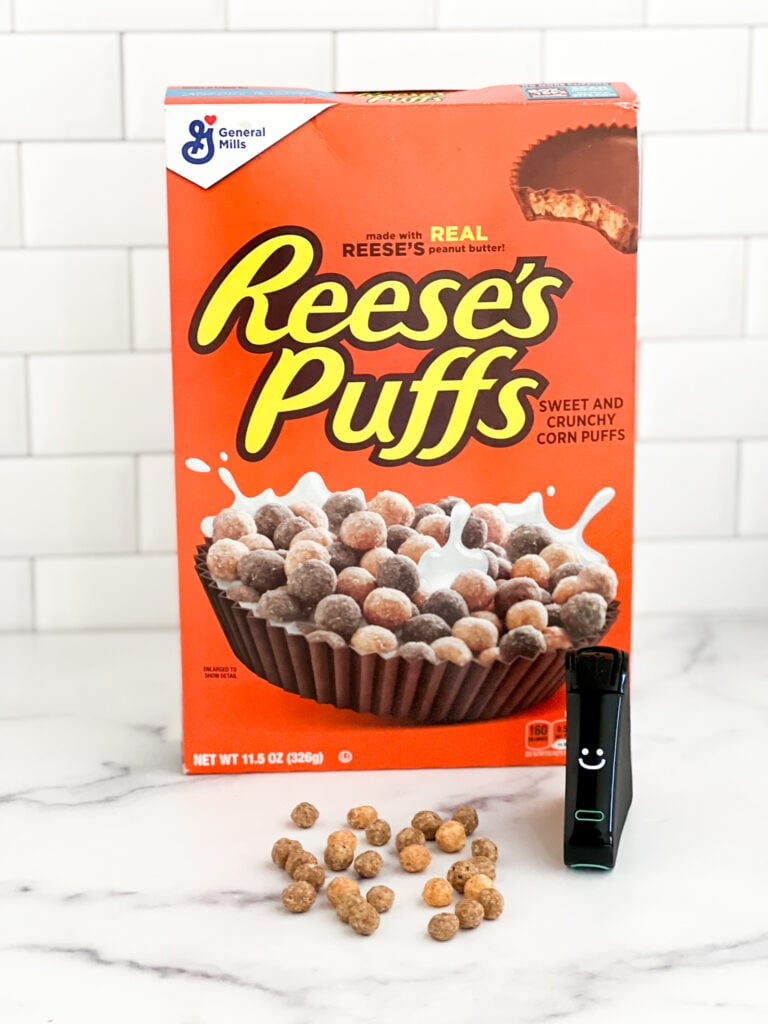
(22) Three Wishes Cereal
Three Wishes makes a grain-free cereal with chickpeas as the main ingredient. It comes in Honey, Cinnamon, Cocoa, Unsweetened, and Fruity varieties. If you’re worried about Cheerios, Three Wishes is a great alternative.


(23) Trader Joe’s
Trader Joe’s offers a delicious Crunchy Almond Butter Puffs Cereal that is gluten-free. The cereal is made from crunchy rice and quinoa puffs coated with almond butter and dusted with powdered sugar and cocoa powder.
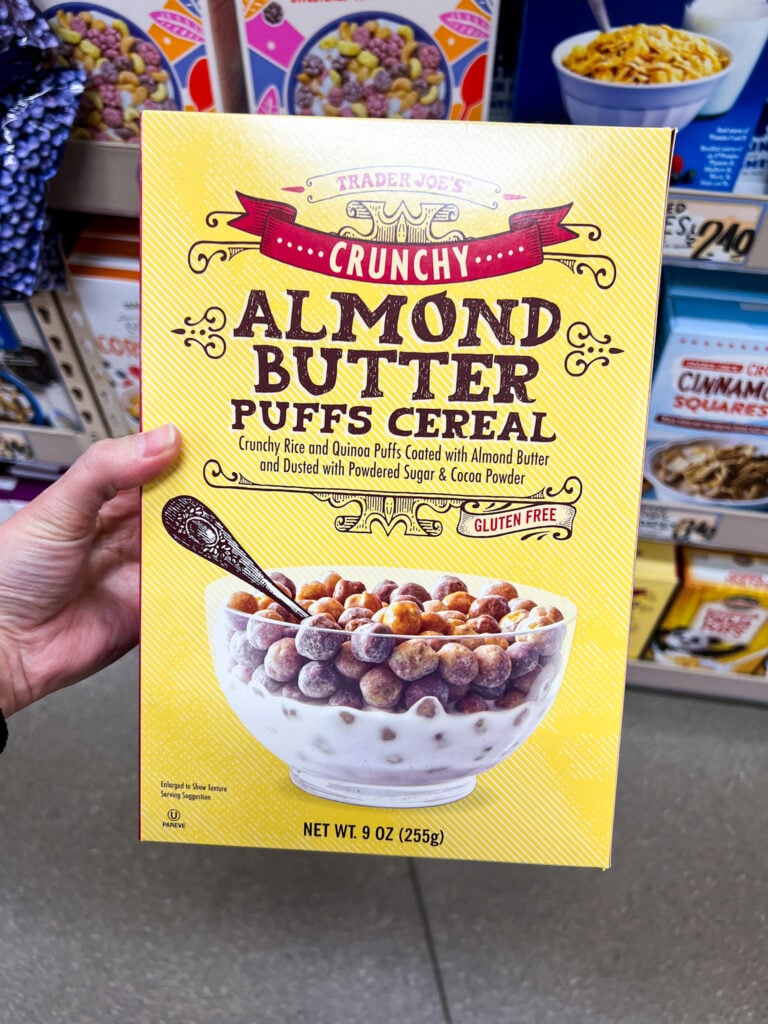
And during pumpkin season, Trader Joe’s Pumpkin O’s are gluten-free and fabulous! Read my review of the Pumpkin O’s here.
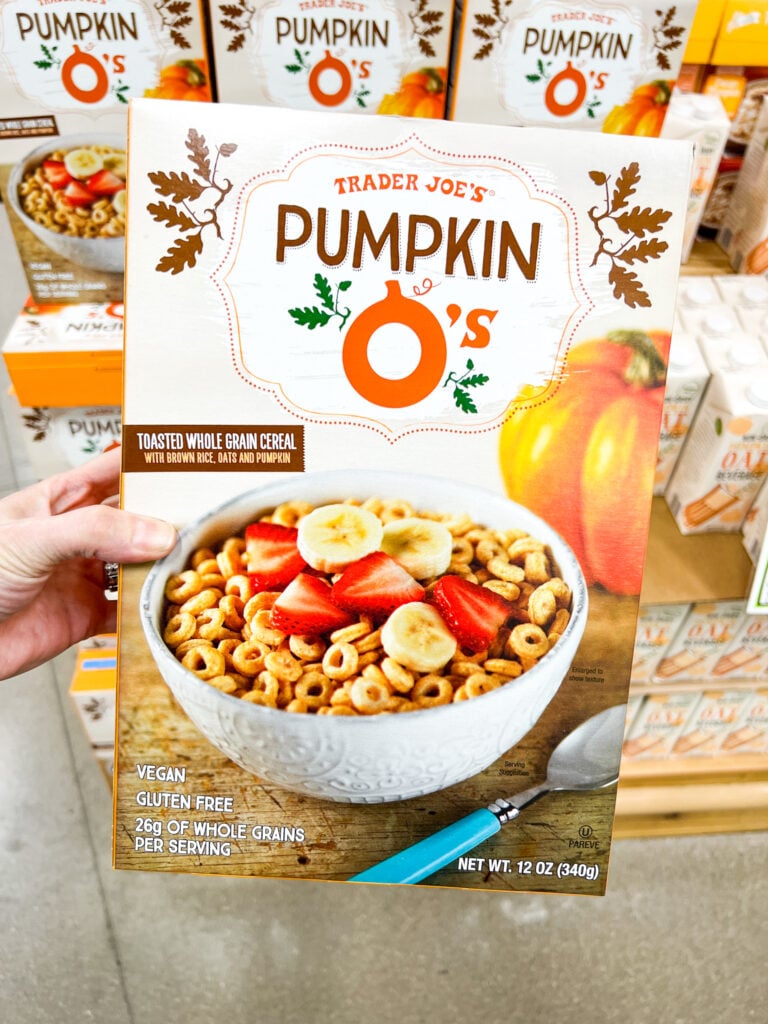
(24) Trix
While not labeled gluten-free, Trix cereal does not contain any gluten ingredients. It’s made from whole-grain corn, sugar, rice flour, corn syrup, oil, and food coloring.
I tested Trix with my Nima Sensor to see if it contained any hidden gluten. Nima came back with a smile (no gluten found).
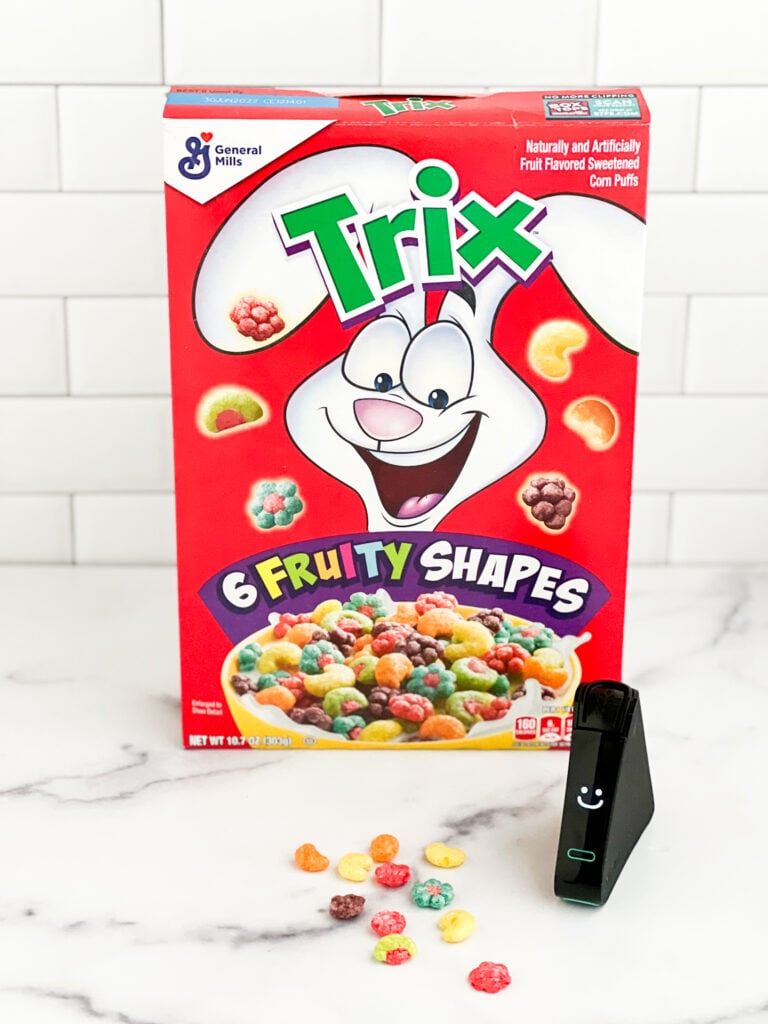
(25) 365 By Whole Foods
Whole Foods’ private label brand, 365, makes Organic Brown Rice Crisps cereal and Cocoa Rice Crips cereal, both of which are gluten-free. You can find it on Amazon or inside Whole Foods.


Avoid these Cereals that Contain Gluten
Cereals that clearly say they contain gluten and should be avoided include:
- Apple Jacks: Contains wheat flour – avoid.
- Cap’N Crunch or Captain Crunch: Although the cereal doesn’t contain wheat, rye, and barley, it has oats, which could contain trace amounts of wheat. The parent company (Quaker Oats) says Cap’N Crunch cereals are not labeled gluten-free because the company cannot guarantee the cereal is free from gluten contamination.
- Cinnamon Toast Crunch: Contains wheat – avoid.
- Cheerios (select flavors only): See above.
- Cocoa Puffs: Do not consume. At the bottom of the ingredient list, it says, “May contain wheat ingredients.”
- Corn Flakes: Contains barley malt extract – avoid.
- Corn Pops: Contains wheat – avoid.
- Cream of Wheat: Contains wheat – avoid.
- Crispix: Nima found gluten when I tested this breakfast cereal – avoid.
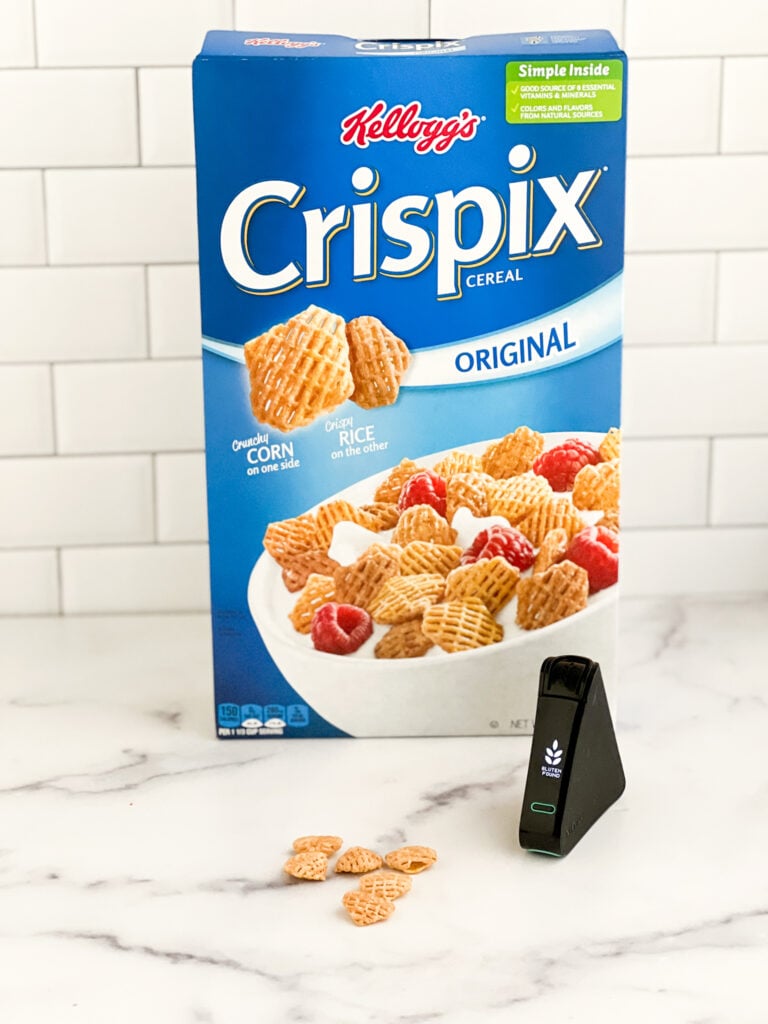
- Frosted Flakes: Contains malt flavor (barley) – avoid.
- Frosted Mini Wheats: Contains wheat – avoid.
- Fruit Loops: Contains wheat – avoid.
- Grape Nuts – contains wheat – avoid.
- Honey Bunches of Oats: Contains malt extract (barley) and non-GF oats.
- Kashi: Contains wheat – avoid.
- Kix: Kix has never been labeled “gluten-free,” but contained no gluten. However, in September 2023, Kix added a “Now may contain wheat ingredients” warning to the front of its boxes.
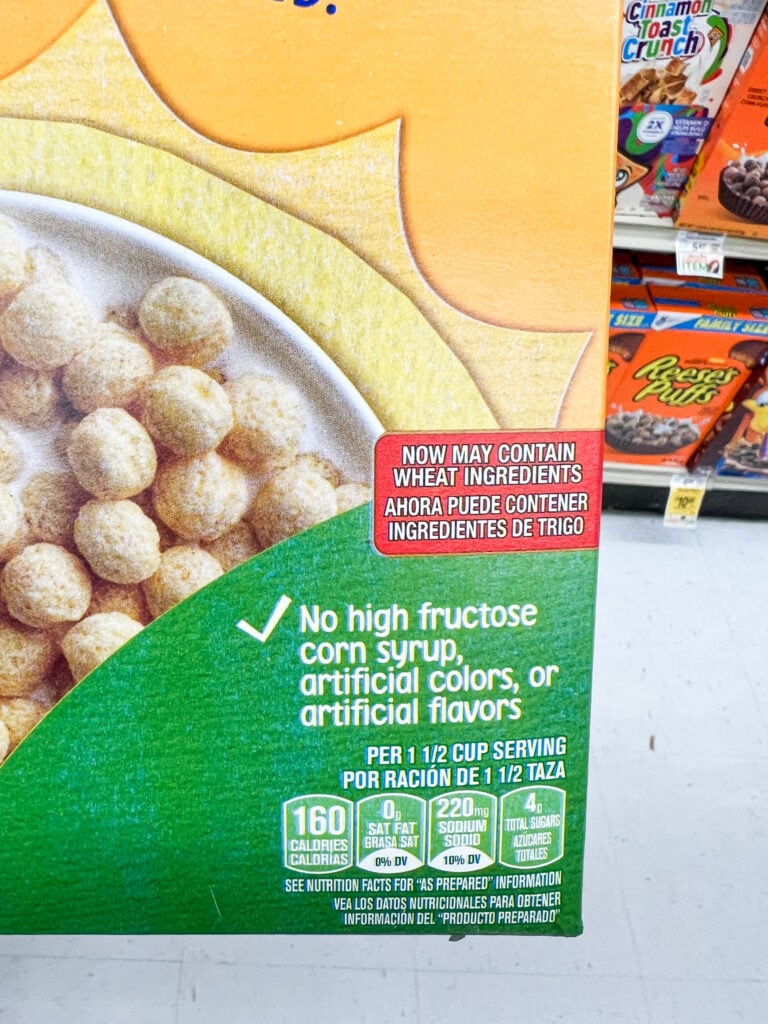
- Life: Contains wheat – avoid.
- Lucky Charms (Chocolate and Fruity flavors only): While the Original Lucky Charms are gluten-free, the Chocolate and Fruity varieties are NOT.
- Raisin Bran: Contains wheat – avoid.
- Rice Krispies: Contains barley malt – avoid. Please note that you can find gluten-free Rice Krispies in Canada. Look for “gluten-free” labeled boxes. Learn more about why Rice Krispies contains gluten.
- Shredded Wheat: Contains wheat – avoid.
- Special K: Contains wheat – avoid.
What Am I Missing?
Am I missing any gluten-free cereal brands you love? Please leave a comment to share. I will update this article with new information as it becomes available.
Need to go gluten-free fast? Enroll in my SIGNATURE Gluten-Free Course and learn everything you need to know about going gluten-free and healing your body.
Related Articles
You might enjoy these articles, too:
- Unpacking the Gluten-Free Cheerios Controversy; Is It Time to Reconsider Your Stance?
- Are Corn Flakes Gluten Free?
- Is Cream of Rice Gluten Free? I Tested It!
- Are Rice Krispies Gluten Free?
- Are Oats Gluten-Free? Unpacking Confusing and Contradictory Information
- Is Oat Milk Gluten Free? The Answer Isn’t As Clear Cut As You Think

Thank you for writing such a detailed article! It is incredibly helpful for celiacs, especially ones new to the whole world of what is and isn’t safe to eat.
Also, I’ve noticed that while name brand Rice Krispies are not gluten free, Great Value brand doesn’t contain any gluten ingredients and seems to be safe. It doesn’t say Gluten Free but I saw no problematic ingredients and no “Manufactured in a facility with wheat” on the box.
Thank you for sharing this information! I know that both of my celiac teens have eaten Cheerios & lucky charms with zero reaction even though some cannot. Even blood work showed their #’s didn’t elevate. They are sensitive to any gluten cross contact. For those that are near an Aldi, they have crispy rice cereal that is gf & sooo good to make rice Krispys.
Kind Honey and coconut granola is gluten free. I have gotten sick several times from eating regular Cheerios. My understanding of the issue is while some boxes have less than 20 ppm of gluten, some have tested considerably more. Anyone who gets as sick as I do from any gluten should avoid it.
Hi there! Could you test puffins cinnamon and regular??!
For anyone who mentioned wheat starch and omission beer, common beers are made with the sprouted flour of barley and so is malt vinegar if malt isn’t labeled extract or syrup, That’s how a gluten free individual can get ill from either of those. some beers have 100 ppm gluten. Malt extract and wheat starch doesn’t compare to each other, Sprouting and roasting processes evidently modify some of the remaining gluten into amino acids so it can dissolve to inject as part of malt extract or roasted wheat (fermented to soy sauces). Whiskeys are distilled though, for it to manufacture, malt extract had to be manually distilled. Maltose should be the way to word malt extract after manual distillation.
Beers the way they’re made without manual process to remove gluten can’t be consumed on gluten free diet, and wheat based beers whether manually distilled or the way it’s made can’t be consumed with a wheat allergy. If nothing, and nothing, but nothing.
cascadian farms fruit os sure isn’t an oat product anymore but rather just a corn product. while without a gluten free claim, it was close to being formulated like any fruit rings cereal, yet rather than a whole ingredient of flour (whether refined to filter out the other grain parts or a whole grain flour), it’s no surprise that toasted oats are made with wheat starch. In the case of cascadian farm, unlike the fruity os down to 2 grams of protein, it’s a surprise that their other toasted oat varieties pure os or honey nut has barley ingredients, whole grain barley flour, sprouted flour of barley, and malt extract. Therefore the other 2 varieties have 4 grams of protein aside from their fruity os.
Did you know about waffle crisp/crunch cereals? It’s made of the same flour sources as any honey wheel cereal. Waffle crisp used to include wheat flour, it was nice that they removed it from formulation, kellogg eggo waffle cereal thoughly has whole wheat flour. Gluten free eggo waffles were once practiced but years ago they made a difficult decision to discontinue it.
I test a small potion of the dry cereal. Nima cannot test for hot spots. Do you experience cross reactivity with other oats products?
How are you testing the cereal exactly? Are you putting it in milk or distilled water (we want clean tests afterall), letting it dissolve down to a mushy mess and then testing the liquid with your NIMA sensor?
The 20 ppm guideline always seemed silly to me, due to the fact that everyone eats a different portion size. For example, at one serving size, Honey Nut Cheerios absolutely destroy my stomach, but Multi Grain Cheerios are fine. It isn’t until I consume an actually filling portion that both wreck me.
I saw someone mentioned wheat starch ingredient as ok. For me, it is not. I would caution anyone who just goes by the “gluten free” label and ignores the ingredient list to check again.
And, it takes less than 20ppm to make a person ill, but they only test down to 20ppm.
Another example is Omission beer. They use barley and then break it down in processing so it tests below 20ppm. Made me ill. It is not truly gluten free. Always check ingredients.
just discovered https://www.maltomeal.com/products/crispy-rice/ Confusing since it is the Malt-o-Meal company but the crispy rice cereal is gluten-free. made a batch of rice crispy treats and they are perfect.
Thank you. I haven’t tested anything from Aldi bc I don’t have a location near me unfortunately.
This info is so valuable. I was diagnosed with Celiac in 2000. So I have been around the block in this battle with little encouragement or help. I am just citations if you have tested the Aldi version of their crops rice cereal? Millville Crispy Rice Cereal
Labeled:
Gluten-Free • Egg-Free • Nut-Free • Soy-Free • Wheat-Free • Peanut-Free • Shellfish-Free • Cholesterol-Free
12oz
There’s a certain name of gluten removed barley malt, Maltose would be the non-gluten part of malt syrup. The following URL proves that storage protein is the only gluten part of it. https://en.wikipedia.org/wiki/Barley_malt_syrup
Maltose would have been enough for a common recipe of corn flakes (even frosted), and rice krispies. Just like kelloggs special K original itself, any rice flakes cereal includes vital gluten (starchless), wheat germ, and malt at any brand. Xanthan gum would work if needed for rice flakes. Replacing malt flavor with maltose would be a minimal change to a cereal recipe. An interesting thing with Allis sensor is lindt candy with malt extract only tested 2 ppm of gluten. Maltose would be the name if malt syrup was distilled.
I’ll have to look into it. Thank you for letting me know.
Hi, I know Kellogg Rice Krispie has gluten (it’s written on the box).
But, Malt O’ Meal Crispy Rice, says it is gluten free. Is there a problem with cross contaminated with the Malt O’ Meal Cereal products?
My nephew is severely gluten and dairy sensitive.
Yes I’m familiar and share this as a limitation in my articles about Nima. Thanks for sharing.
Did you know nima sensor can only be guaranteed to test gluten found with full peptides of it (not hydrolyzed or fermented processed wheat/barley ingredients)? No test result of GF smiles are reliable with a broken fragments of gluten. Though barley malt (only sub ingredients not to apply to (malted barley flour) as it’s considered a main ingredient) are commonly processed just to shatter the gluten but not remove it. Milky way candy (same varieties as 2 total grams of protein as a hint) including original variety somehow triggered gluten found which isn’t possible once the gluten is hydrolyzed into broken fragments of it. The barley enzyme which made brown rice syrup no different from malt flavor must have been neither fermented or hydrolyzed with the gluten remaining in a full peptide to trigger the positive result.
There’s hardly GF recipes of raisin bran Heinen/Greenwise brands of it Greenwise however used to do a common recipe made of wheat with malt flavoring as the same cereal, some common reciped brands call it barley flour of a malt ingredient. Don’t know why greenwise would switch to rice and corn based recipe of raisin bran. I also found some brand of GF reciped fruit loops (panjon swad, percy, and wow confetti fruit ring cereal brands) they’re made or corn rice and oats. I thought fruit loops have to bind up with glutenin. Those GF versioned brands don’t have xanthan gum.
I did not test it if it contained obvious sources of gluten.
did corn pops, and honey combs/buzzers cereals test gluten found? those have wheat starch which is typically processed to separate from gluten. corn pops jumbo snax pouches however has fresh wheat flour which is always gluten sourced. I somehow found most brands of oat ring cereal as well has wheat starch (used to include general mills cheerios), most airhead extreme kinds has wheat starch, filled ropes and soft filled bites however could only have glucose syrup/dextrose to declare wheat while lengthed piece kinds including sweetly soured rolls has wheat flour.
Nature’s Path EnviroKidz makes a similar but gluten-free Frosted Flake cereal
What about a substitute for Frosted Flakes??
Great question. I would but I know some people wouldn’t. I respect everyone’s level of comfort and risk. Hope that helps!!
Hi Jenny,
Would you eat some of the cereals you tested that were GF despite not being labeled as GF? I am not sure about the risk.
There are GF suggestions in the article but I can’t think of a replacement at the moment for Raisin Bran.
Any ideas for replacement Raisin Bran? Used to be my favorite cereal.
KIND makes a cereal that is gluten free and it’s like honey bunches of oats and they have a chocolate almonds one too!
Agree. And I think you meant aren’t vs are.
It pisses me off that Rice Crispies are gf. They’re rice?! Ugh.
So sad about Crispix, too. Corn Pops, come on Kellogg’s get on the Gluten free band wagon. Thanks, Jenny.
So sad about Crispix, but good to know!
Oh I haven’t but I’ll look for them when I’m ready to add to this article. Great idea.
Hi Jenny! Seeing that it’s Halloween time have you tested any of the General Mills monster cereals? No gluten ingredients but not labeled gf. I used to love Count Chocula as a kid!